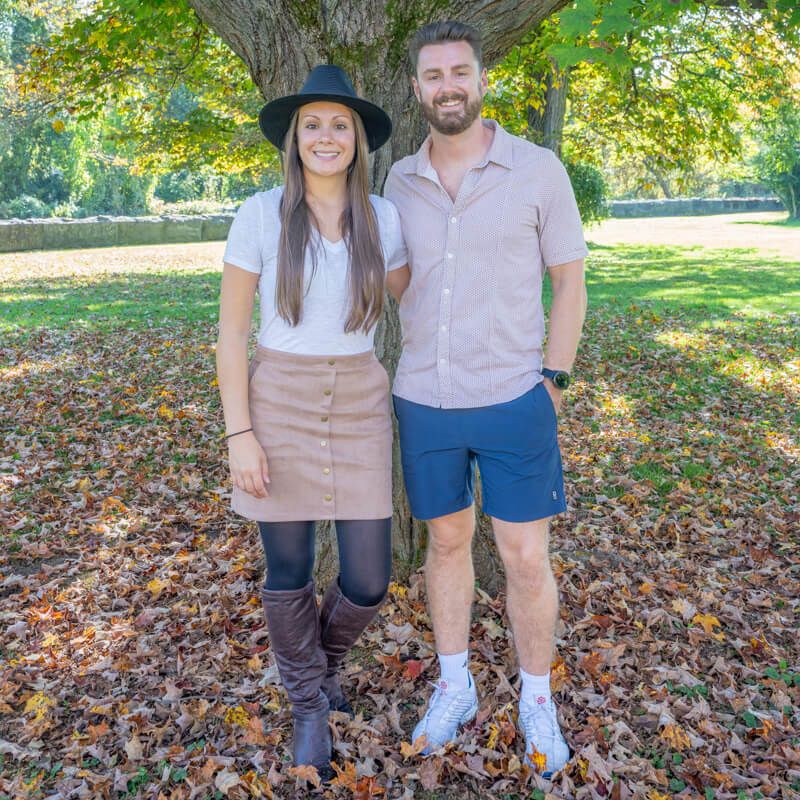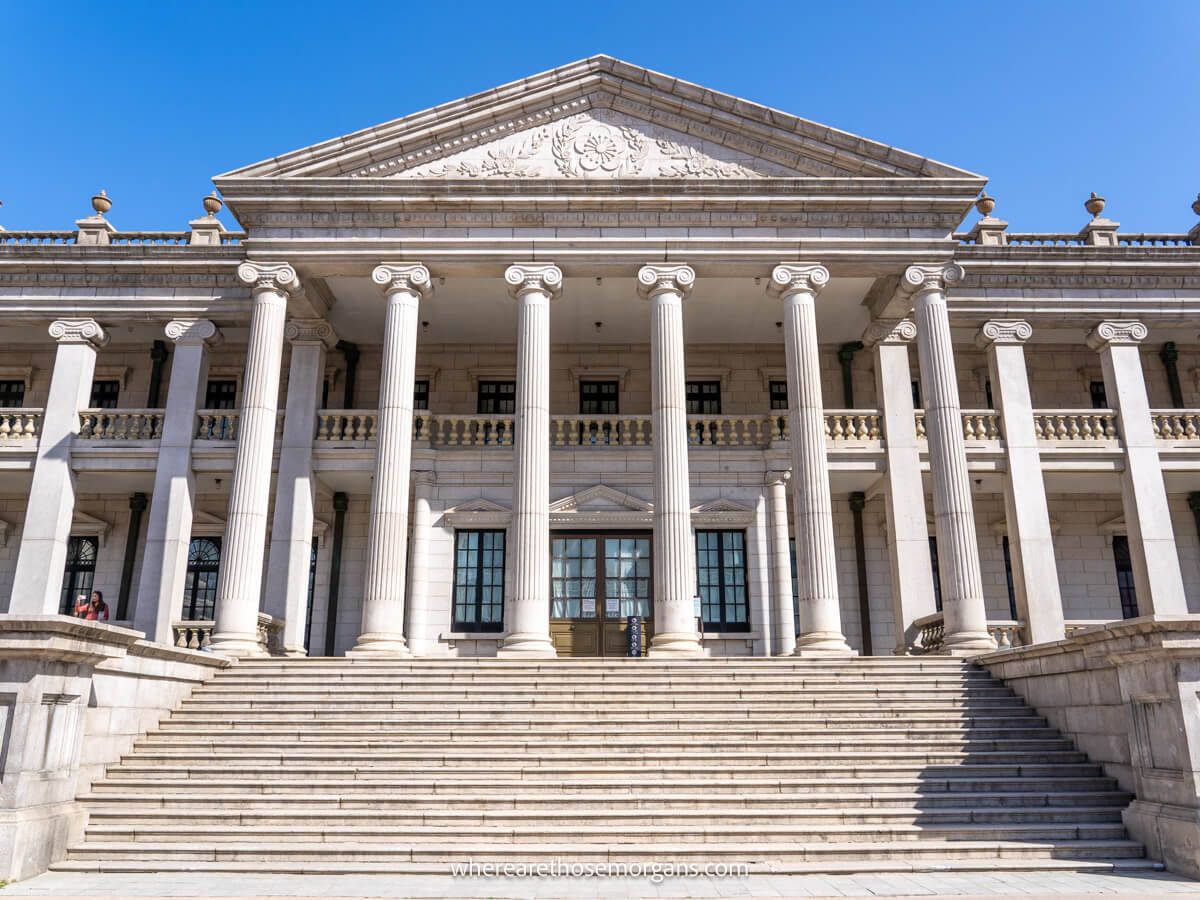Located directly across the street from City Hall in downtown Seoul, Deoksugung is one of the least visited palaces in the city. It was first used by King Seonjo and continued to have various uses throughout the years. The complex now houses two museums and it’s one of the cheaper palaces offering free guided tours.
In this guide, we’re going to show you the highlights of Deoksugung Palace including what you should see for your visit.
Our Seoul Experience
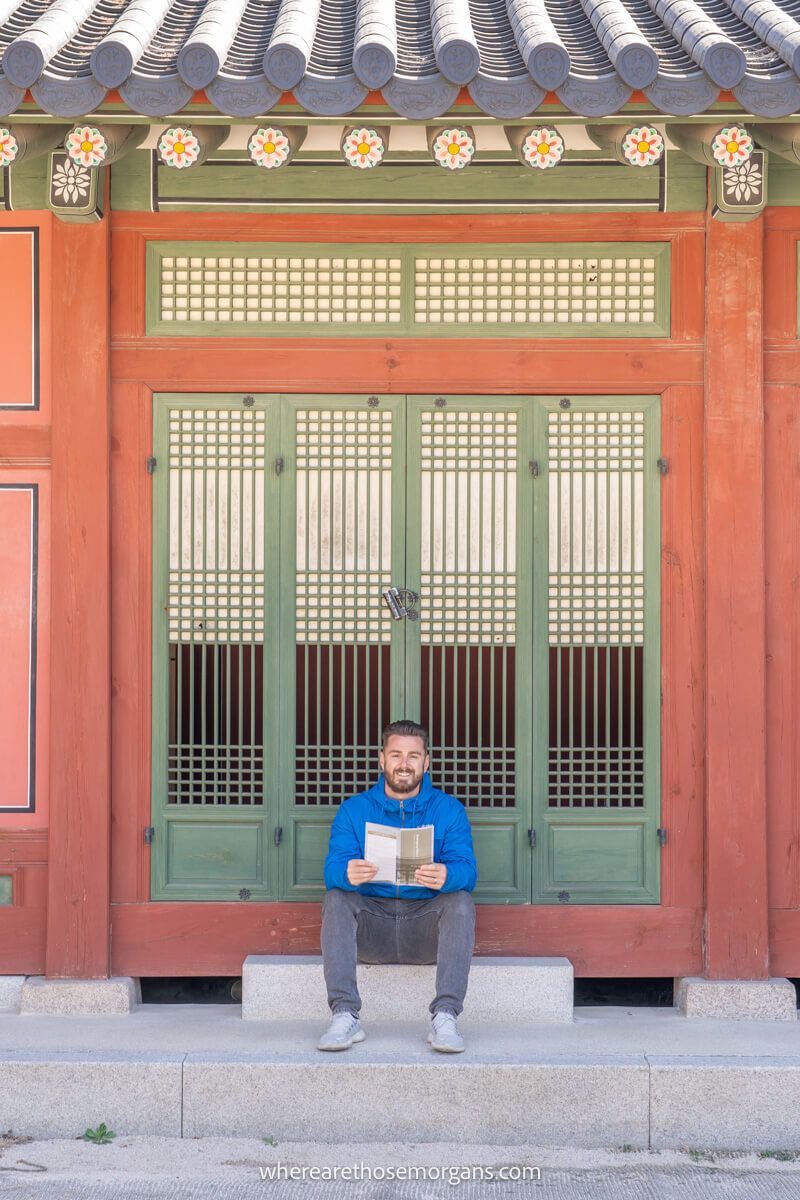
We spent 14 days exploring Seoul in March 2023. During this trip, we personally toured Deoksugung Palace as well as the 4 other royal palaces in Seoul. This is one of the lesser known palaces in the city, but we thoroughly enjoyed visiting because the crowds were smaller.
Deoksugung is located in a great neighborhood very close to Seoul City Hall and there is so much to do nearby. We started our day at the palace with the changing of the guard ceremony then continued to visit other attractions in the same region. Read more about us.
Deoksugung Palace History
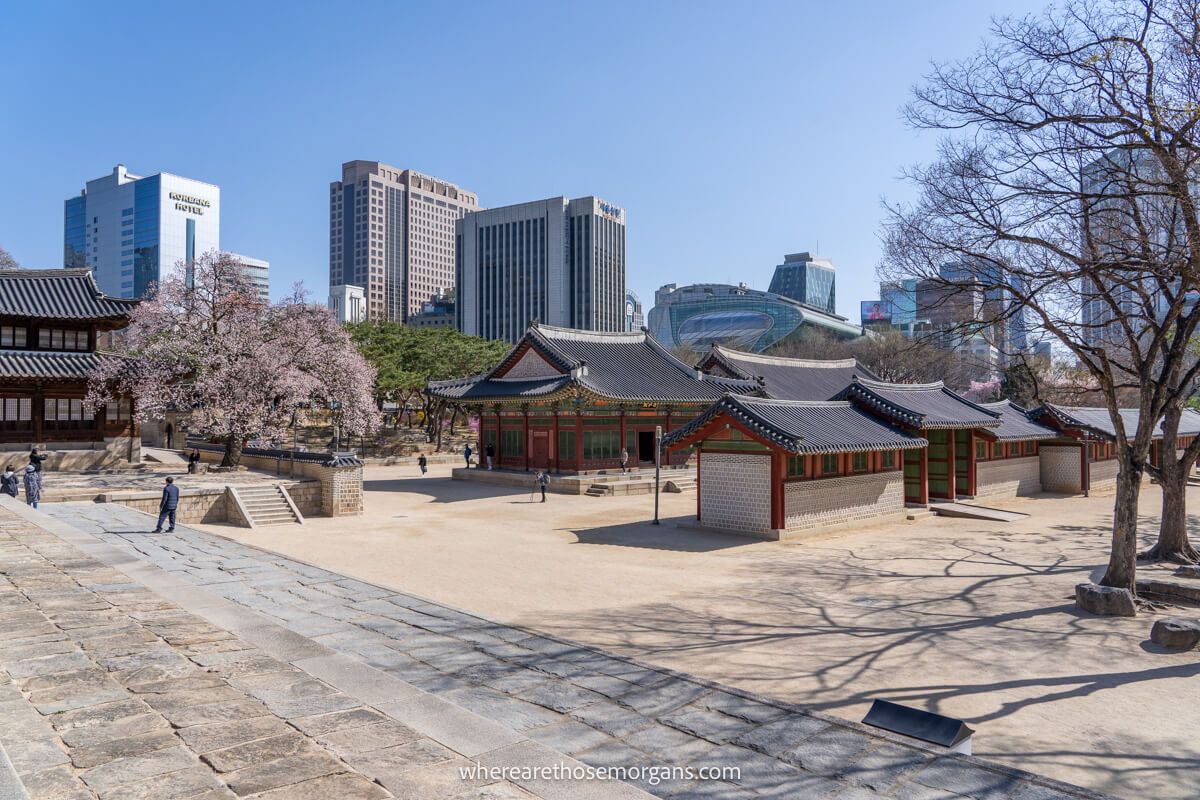
Now registered as Historic Site No. 124, Deoksugung Palace was initially used as a residential home for King Seonjo, the 14th King of the Joseon Dynasty as he took refuge from the Japanese invasion of 1592 when the other palaces were destroyed.
In 1611, Deoksugung became an official royal palace in Korea when Prince Gwanghaegun (1575-1641) ascended to the throne, moved to Changdeokgung and changed the official name to Gyeongungung Palace.
When Emperor Gojong came to power over the Korean Empire in 1897, this complex served as an imperial court and palace. Western buildings were built within the grounds to showcase a blending of the traditional and western culture.
In 1907, the name was officially changed to Deoksugung Palace, meaning the palace of virtuous longevity. Unfortunately, after the death of Emperor Gojong in 1919, the palace was significantly downsized and it became a part of the Japanese Empire’s park development project.
However, extensive restoration projects began in 2007 that have revitalized the palace into what we can see today. While it has an inconstant history, we think this is one of the most interesting palace complexes in Seoul.
Visitor Information
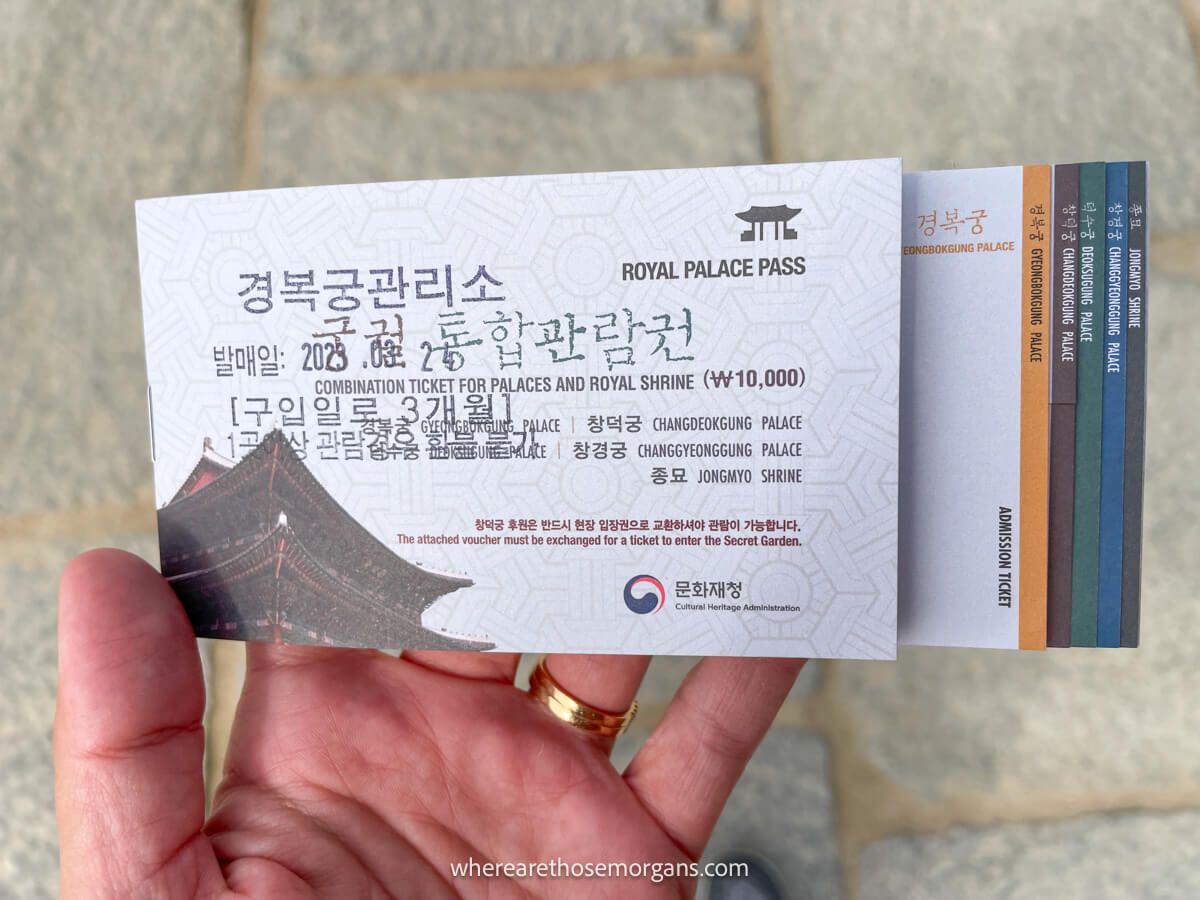
The Deoksugung Palace is located across the street from City Hall in heart of Seoul. It’s open every day of the week from 9:00 to 21:00, but closed on Monday with last admission at 20:00.
- Address: 99 Sejong-daero, Jung-gu, Seoul, South Korea
- Location: Google Maps
- Best subway stop: City Hall Station (line 1, exit 2 and line 2, exit 12)
Admission tickets for Deoksugung Palace cost 1,000 KRW for adults (US$ 0.75) or 800 KRW (US$ 0.60) with groups of 10 or more. Visitors over the age of 65 and children under the age of 19 will receive free entry into the palace. You can also visit for free on Culture Day, which is the last Wednesday of every month.
We think the easiest way to purchase tickets is on site, but if you plan to visit all 5 of Seoul’s royal palaces, you should consider the royal palace pass. This is what we used to visit Deoksugung Palace.
The royal palace pass costs 10,000 KRW (US $7.53) and it’s valid for three months from the date of purchase. This pass can only be purchased from the sites listed below:
- Gyeongbokgung
- Changdeokgung
- Changgyeonggung
- Deoksugung
- Jongmyo Shrine
It’s a good opportunity for those who want to visit numerous palaces in the city because it will save you a little bit of money. Additionally, it also saved us some time by not having to wait in a long ticket line.
However, if you’re planning to wear a hanbok, you’ll receive free entry into the Deoksugung Palace so do not buy a royal palace pass.
Travel Tip: A hanbok is traditional Korean clothing and it’s typically rented by the hour or day. You can also choose to have your hair or make up done as well.
Deoksugung Tours
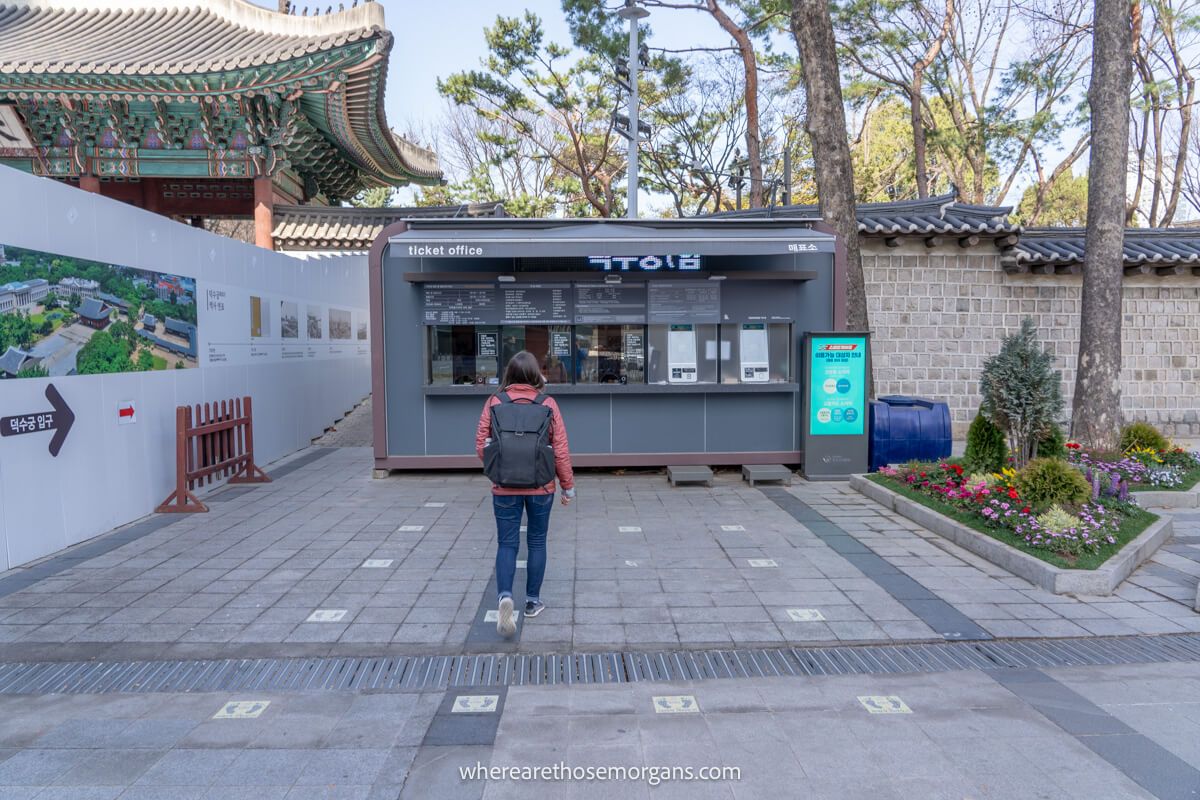
When we visited, we used the free informational brochure to walk around the grounds and see the various buildings. There are also several exhibits placed throughout the compound or you can rent an audioguide at the main entrance for additional information.
But if you want to learn from a local guide, you can attend one of the free 60 minute guided tours offered in various languages. Here are the guided tour times:
- Chinese: 10:00, 14:30
- English: 10:30, 13:30
- Japanese: 9:30, 16:00
In addition to a tour of the grounds, you can also book a tour of the exhibition floor in the Daehan Empire History Museum. This is another free tour, but a booking is required and space is limited. You’ll need to add your name to the waiting list at the museum entrance. The english tour starts at 11:50 or 14:50 and only foreigners are allowed.
If you can’t visit during the free guided tour hours, you can book a tour with a third party company. Many of these tours include admission to the palace as well as some of the best things to do in Seoul.
Here are highly rated tour options:
- Morning or Night Walking Tour – A two hour guided tour through Deoksugung Palace
- Three Hour Walking Tour – Tour of Deoksugung Palace, Gwanghwamun Square and Jeongdong-gil
Travel Tip: We tried to take the Daehan Empire History Museum tour, but there were already too many people on the waiting list. So if this is something you’re interested in, add your name to the list as soon as you arrive.
10 Best Things To Do In Deoksugung Palace
There are many beautiful buildings you should see when visiting, but a highlight is the changing of the guard ceremony. So if you missed the ceremony at Gyeongbokgung, you can see it here.
We think this palace complex is unique because it features museums and European architecture you won’t find anywhere else. Here is what to you should see at Deoksugung Palace:
1. Daehanmun Gate
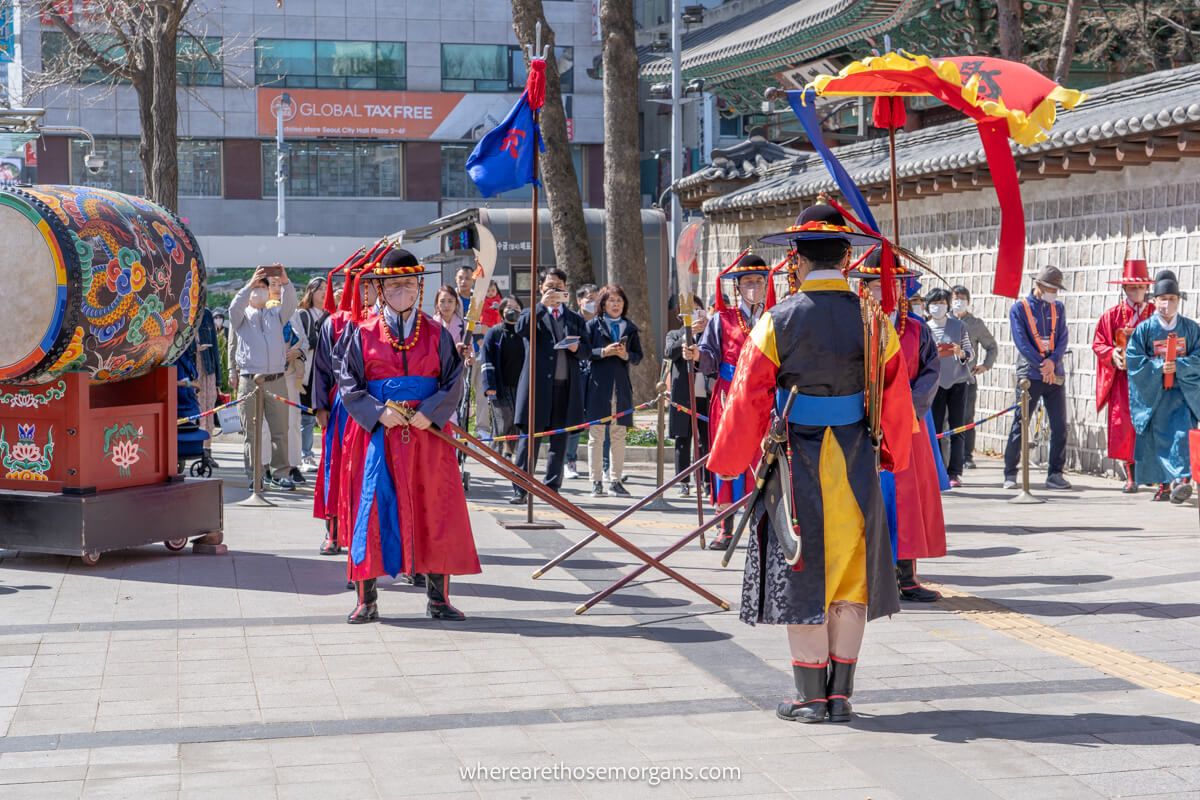
Renamed in 1906, the Daehanmun Gate is the main entrance of Deoksugung Palace. The gate faces east and it’s the only one story front gate in all of Seoul’s 5 royal palaces. The beautiful calligraphy on the front of the gate was created by Nam Jong-cheol, a high ranking official during the reign of King Gojong.
The changing of the guard ceremony at Deoksugung Palace takes place in front of Daehanmun Gate. This ceremony dates back to the Joseon Dynasty when the guards who watched the royal palace gates changed shifts.
We highly recommend you try to watch the ceremony because you’ll see royal uniforms and weapons as well as hear traditional instruments. If you’ve seen changing of the guards at Buckingham Palace in London, it’s very similar.
Travel Tip: The Deoksugung Palace changing of the guard ceremony takes places in front of Daehanmun Gate at 11:00, 14:00 and 15:30.
2. Geumcheonkyo Bridge Remnants
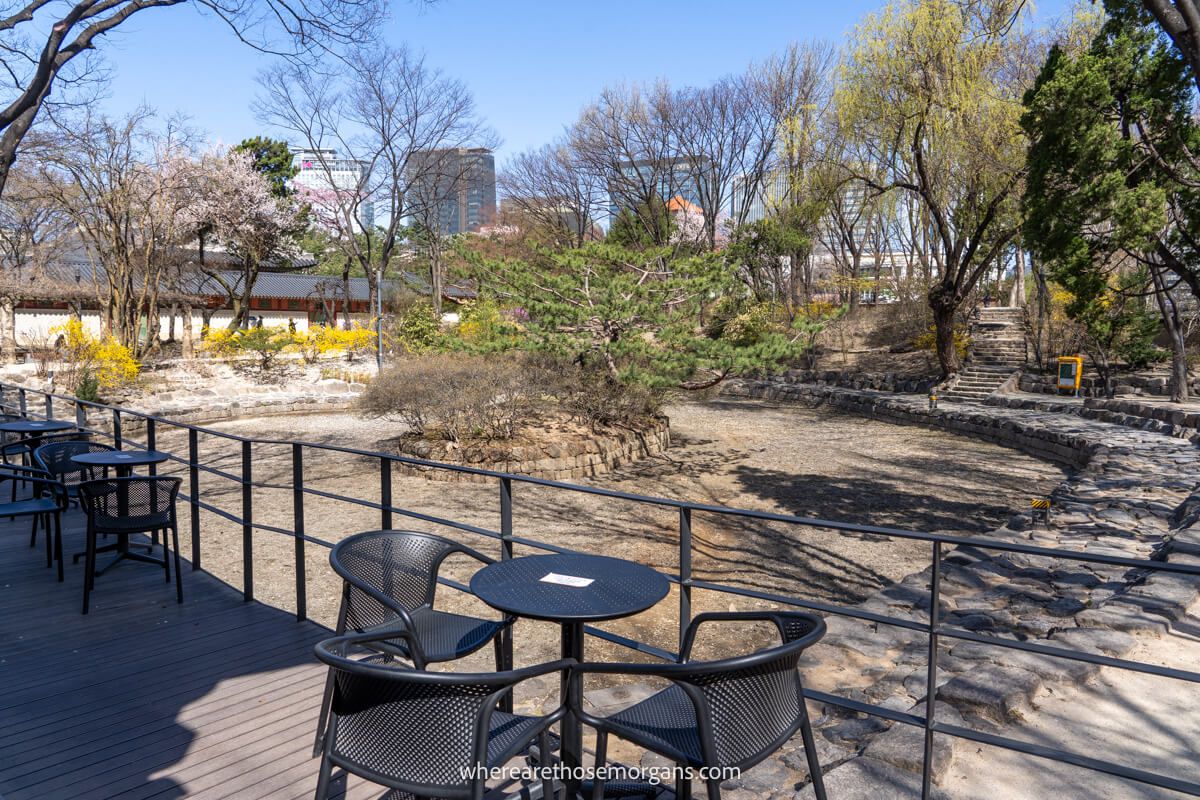
The Geumcheonkyo Bridge was different from other bridges inside Seoul’s royal palaces because there was no natural stream. The complex was originally built as a private residence, but once it officially became a palace, an artificial waterway was dug and Geumcheonkyo Bridge was built over it.
While you can no longer see a steam, the waterway has since been turned into a pond. When we visited in March, the pond was completely dried up, but there was a nice sitting area nearby.
3. Junghwamun Gate
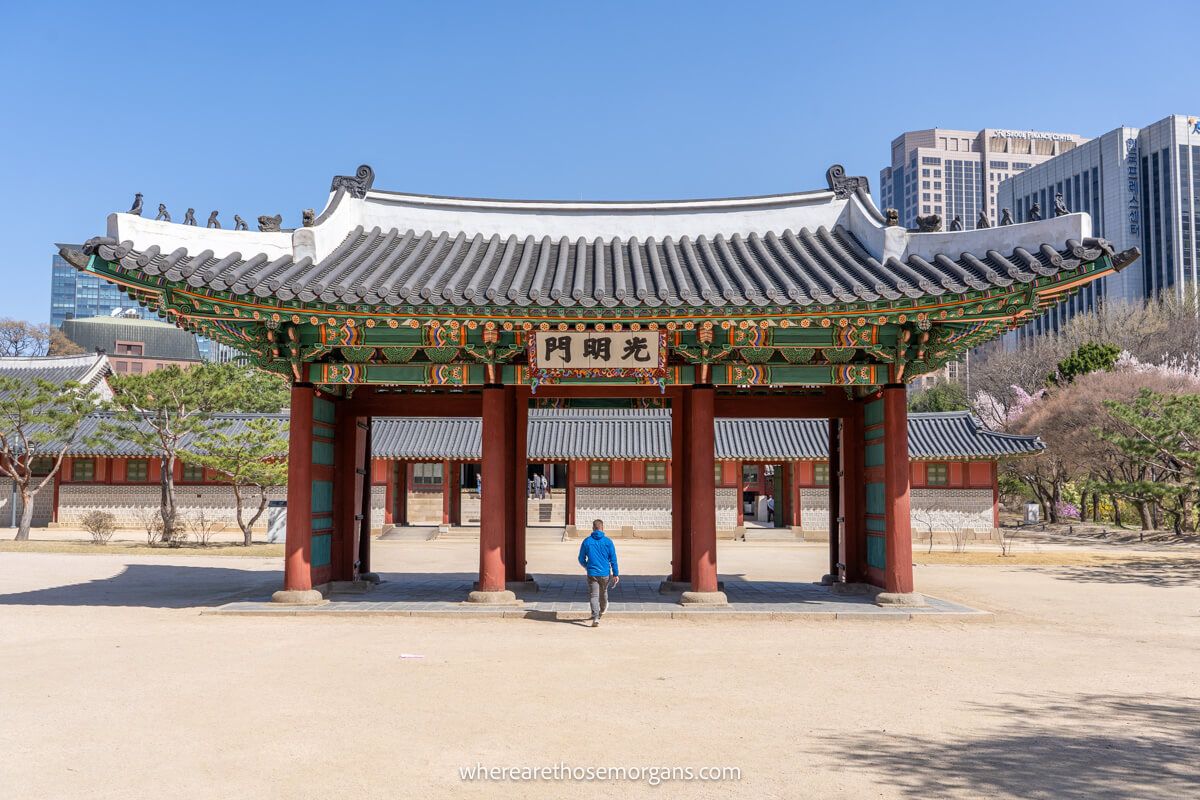
The Junghwamun Gate sits directly in front of Junghwajeon, the main throne hall of Deoksugung Palace. And as you can see in our photo above, you’ll be able see the main hall through Junghwamun Gate.
We recommend you approach the main throne hall through Junghwamun Gate for a great perspective of the city. The gate was rebuilt in 1906 after a fire destroyed many of the buildings inside the grounds. But we think it’s interesting how you can see the older architecture sitting right next to modern day buildings.
4. Junghwajeon Hall
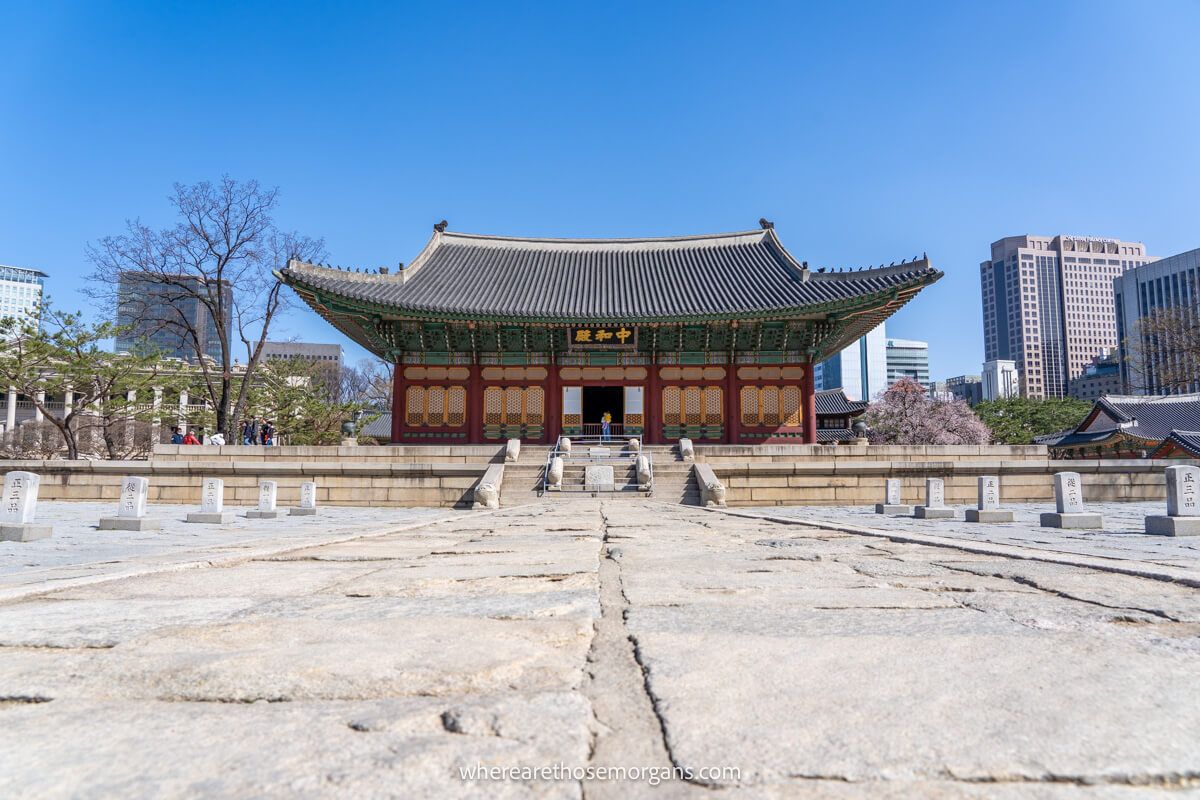
Junghwajeon Hall is the main throne hall of Deoksugung and it’s one of the most interesting buildings in the complex. As you approach the building, you can see several rectangular stones, known as pumgyeseoks, which were used by military officials to line up by corresponding rank during ceremonies.
When you get closer to the building, you’ll also see four mystical animals carved into the stone along the stairs which function to help protect the building. And once you make it to the large hall, you’ll find a throne on a high platform. A wooden folding screen showcases designs of the sun, moon and mountain behind the throne.
This building was used by King Gojong to hold official functions. Plan to spend some time admiring this hall. We loved the intricately carved ceiling, but there is so much to take in. Junghwajeon Hall is well known for it’s beauty at night and the lights typically come on after sunset. So if you happen to visit later in the day, don’t miss this hall.
Travel Tip: You’ll see pumgyeseoks at all of the other royal palaces in Seoul too.
5. Korean Art Museum
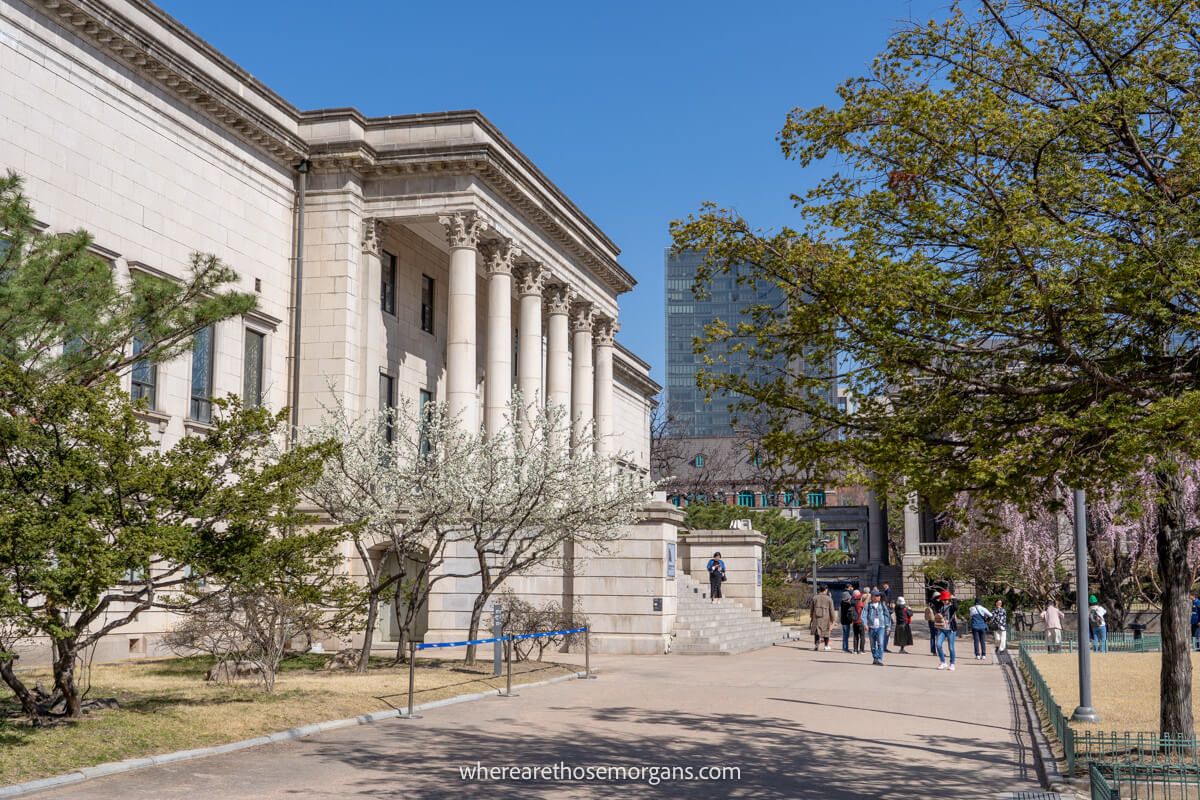
Deoksugung is unique because it’s the only palace in Seoul with an art museum. Inside the complex, you’ll find a branch of the Korean Modern and Contemporary Art Museum. However, you’ll have to pay an additional fee to enter the museum because it’s not included in palace admission.
It’s open from 10:00 to 18:00 Tuesday, Thursday, Friday and Sunday as well as 10:00 to 21:00 Wednesday and Saturday. The museum was closed for a private event when we visited, but if you want know to more you can visit the official website here.
Travel Tip: Free admission is given to individuals under 24 or over 65 and undergraduate students.
6. Seokjojeon Hall
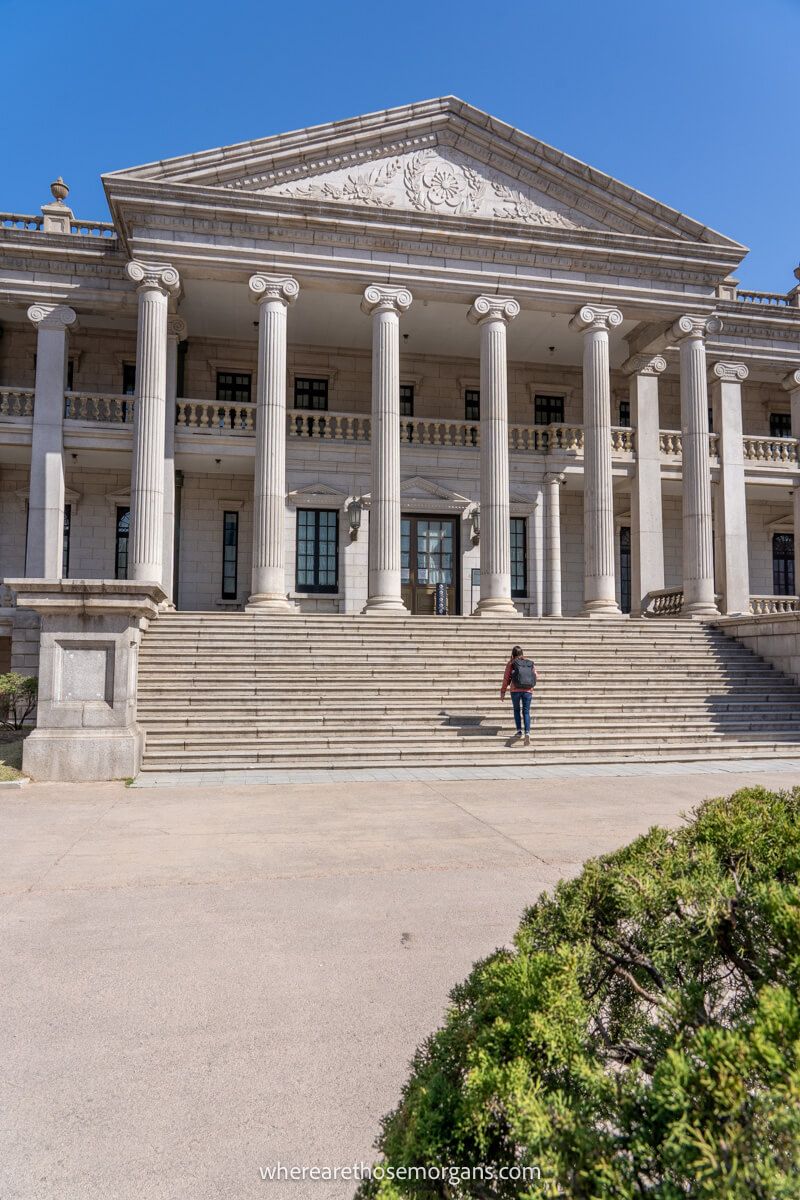
Originally built in 1910, Seokjojeon Hall looks very different to the rest of Deoksugung Palace showcasing a Neo-Classicist style. It’s served various purposes including housing the National Museum of Korea. But after restoration in 2014, it was reopened as the Daehan Empire History Museum.
Seokjojeon Hall was one of the first western buildings in Korea and it represented King Gojong’s hope for sovereignty of the nation. The building stands as a symbol for Korea’s modernization as well as incorporation of the western culture.
On the ground floor, you can find free exhibits detailing the modernization of the Daehan Empire and surrounding neighborhood. This floor was originally used by the attendants of the imperial household.
If you choose to book the free guided tour, you’ll visit the first and second floor. These floors reproduce the formal spaces of the Korean imperial family including the bedchambers, study, living room, grand dining room and reception room.
7. Jeukjodang Hall
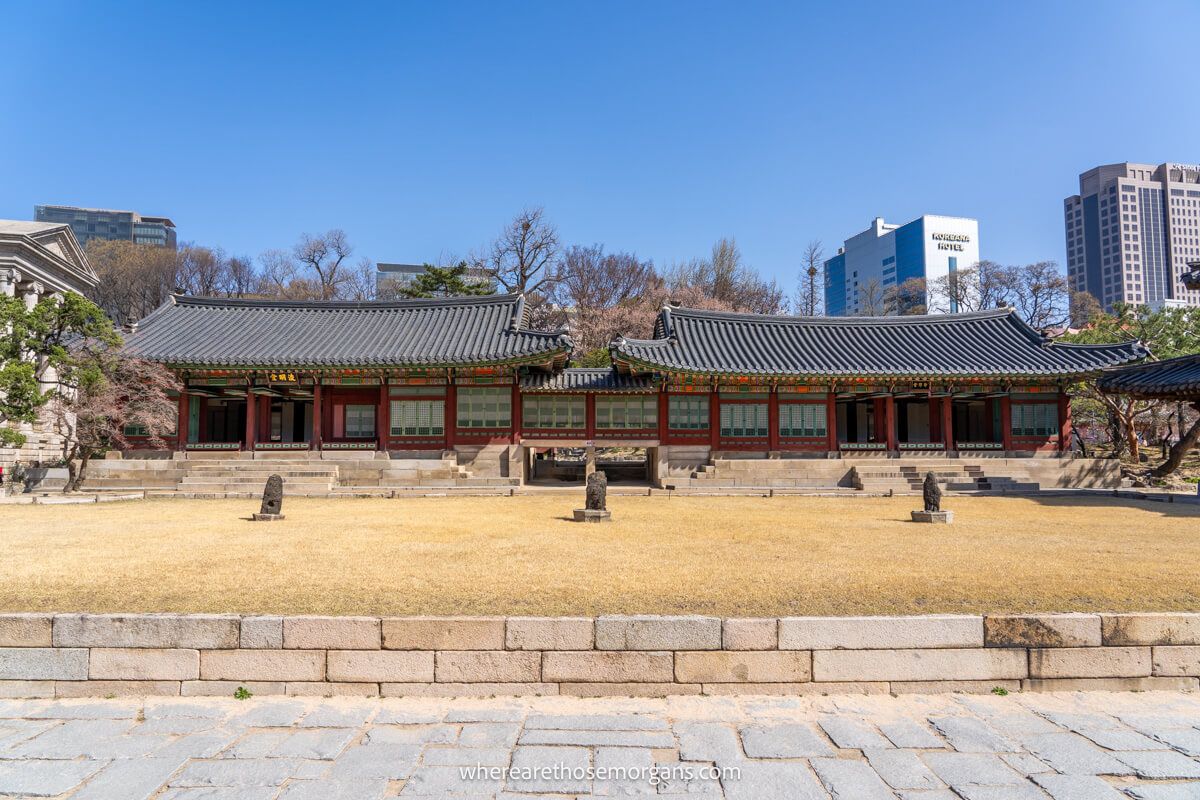
The Jeukjodang Hall is an important building inside the Deoksugung Palace complex because King Sunjong ascended to the throne here. It was originally located slightly north of the building we see today. While the original building was burned in 1904, it was rebuilt in the following year.
The open wooden floor is located on the eastern side of the building, but it was not large enough to be a living quarter.
8. Jeonggwanheon Hall
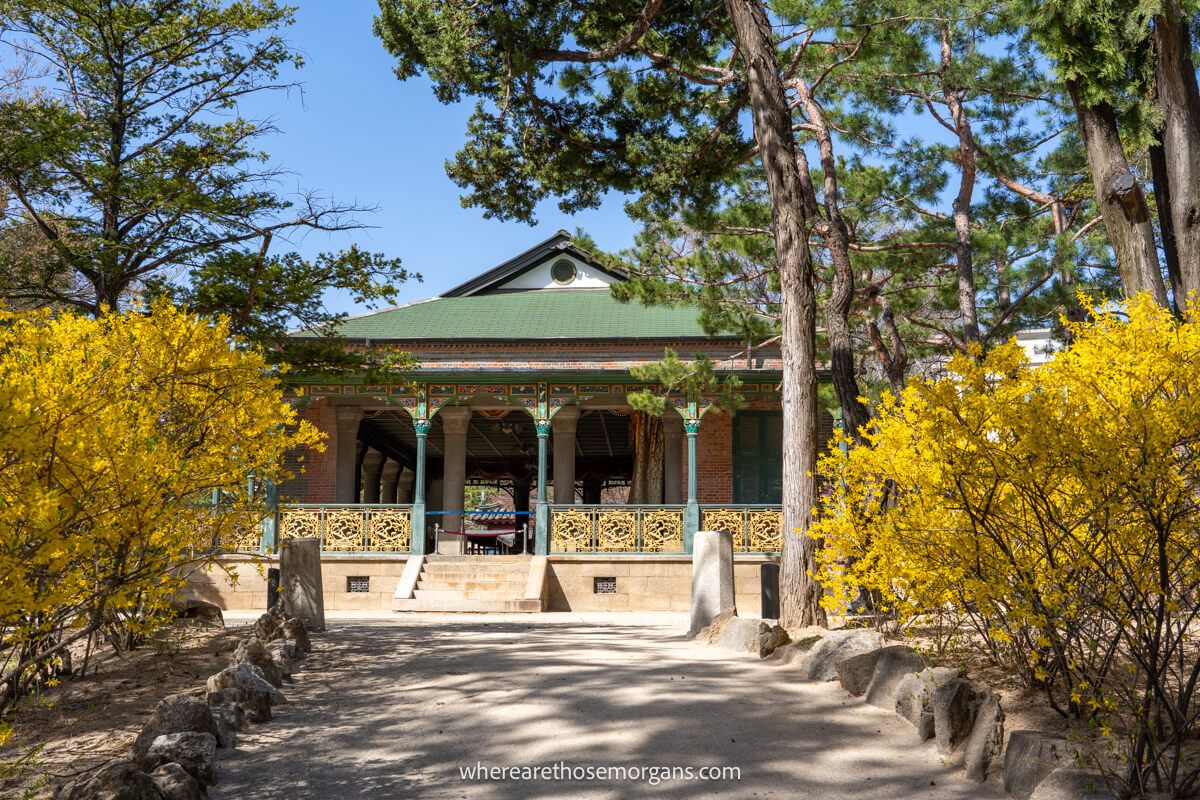
One of the most interesting buildings inside Deoksugung Palace is Jeonggwanheon Hall. Built in 1990, this is the first example of European architecture used within a royal palace in Seoul. But even though it features a western style, it showcases Korean elements such as colorful florals and gold decorations.
The hall was originally used to hold parties and entertain guests. Unfortunately, visitors are not allowed to enter Jeonggwanheon Hall, but you can easily observe it from the outside. It’s interesting to note both the inner and outer rows of wooden columns are Romanesque in design.
Travel Tip: There is a small garden directly next to this hall and it was filled with stunning cherry blossoms in spring. We spent about 20 minutes taking beautiful photos in this spot.
9. Jungmyeongjeon Hall
The Jungmyeongjeon Hall was originally built as an imperial library to store valuable books and other important objects, but it sadly became the place of a tragic historic event. In November 1905, the Korean imperial government was persuaded under threat of military force to sign the Japanese Protectorate Treaty by Imperial Japan.
After it was signed, Emperor Gojong immediately tried to fight the injustice of the treaty, but he was forced to abdicate the throne because it took away Korea’s diplomatic sovereignty. During our visit, Jungmyeongjeon Hall was closed for renovation work, but it contains four floors with exhibits about what happened here.
10. Gojonguigil Pathway
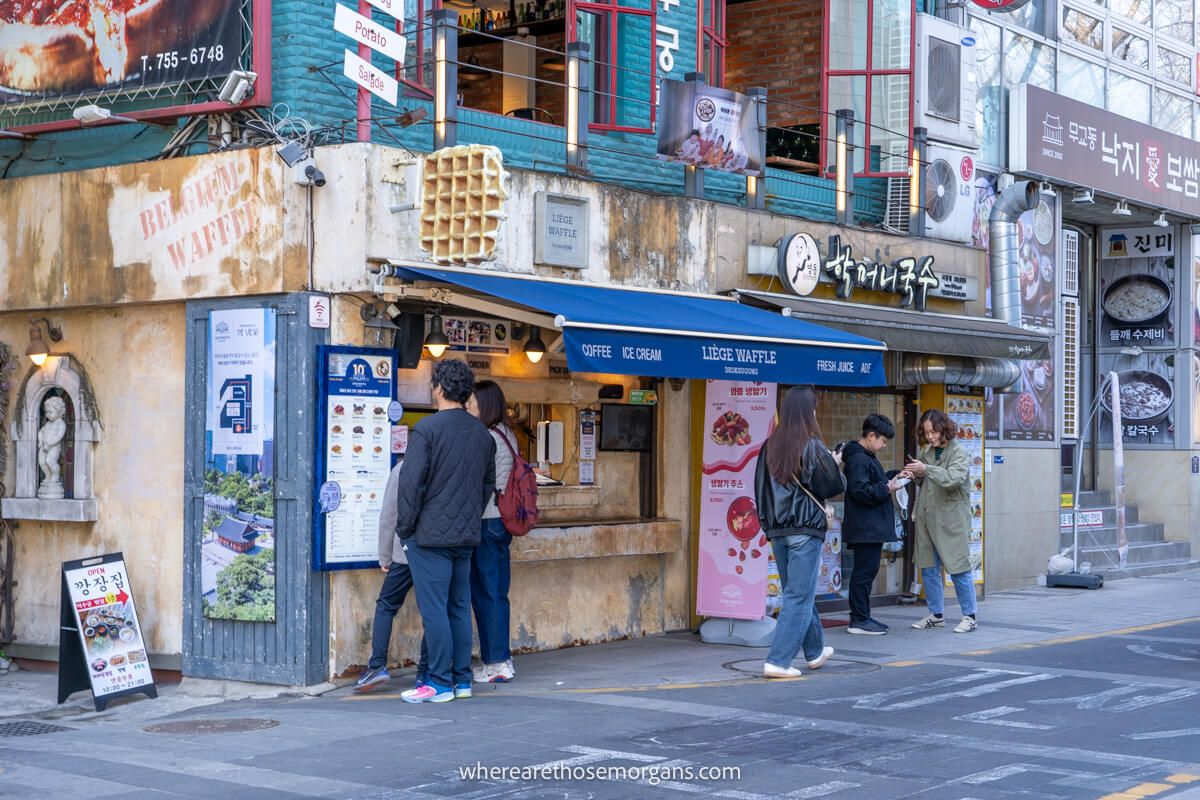
The Gojonguigil Pathway is the famous stone walkway on the outside of Deoksugung Palace. This is a beautiful pedestrian friendly one way road in the middle of the city.
The official street is known as Deoksugung Stonewall Walkway. There is a saying that couples who walk down this pathway will eventually break up so you better think carefully before adding this to your Seoul itinerary!
Regardless of the rumors, we walked the stone walkway and found it to be worth our time because it’s filled with art benches and ceramic tiles. You can also find the Seoul Museum of Art. If you’ve worked up an appetite from walking around the palace, there are numerous restaurants or snack options along the pathway.
The Morgan Conclusion
As one of the lesser known palaces in Seoul, Deoksugung is unique because it features two museums and examples of western architecture. Visitors can also see changing of the guard in front of Daehanmun Gate three times of day.
So is Deoksugung Palace worth visiting?
Yes, the Deoksugung Palace is worth visiting because this is the smallest palace in Seoul and you can easily visit the grounds in about an hour. It’s also easily accessible and located near Seoul’s busiest downtown intersections directly across from City Hall. We like this complex because it’s a great place to see examples of historic architecture directly next to modern day buildings.
This is one of our favorite palaces in the city because it features interesting exhibits about Seoul’s history and a beautiful pedestrian friendly path next to the stone walls. When compared to Gyeongbokgung, there were not as many visitors wearing hanboks so this could be a great option for those who want to avoid the crowds.
Our Deoksugung Palace Photos
We enjoyed our visit to the palace and took many photos. Here are a few of our favorites so you know exactly what to expect:
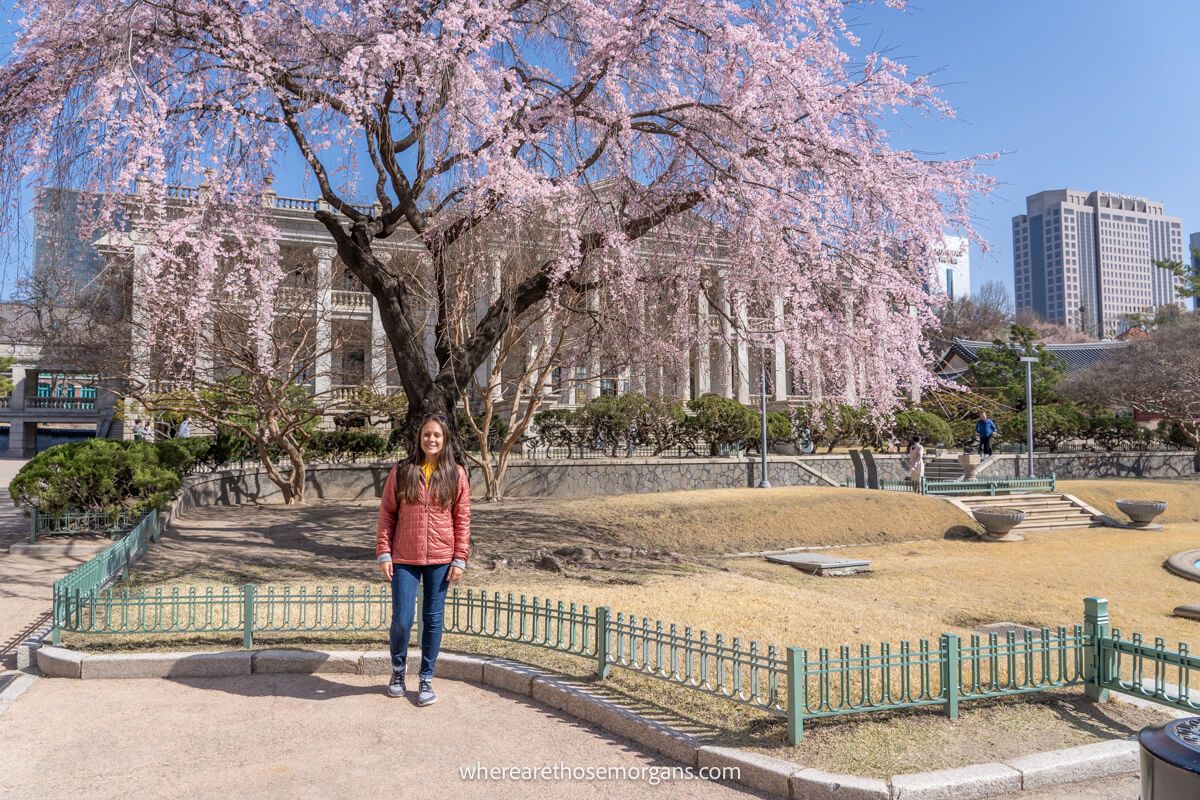
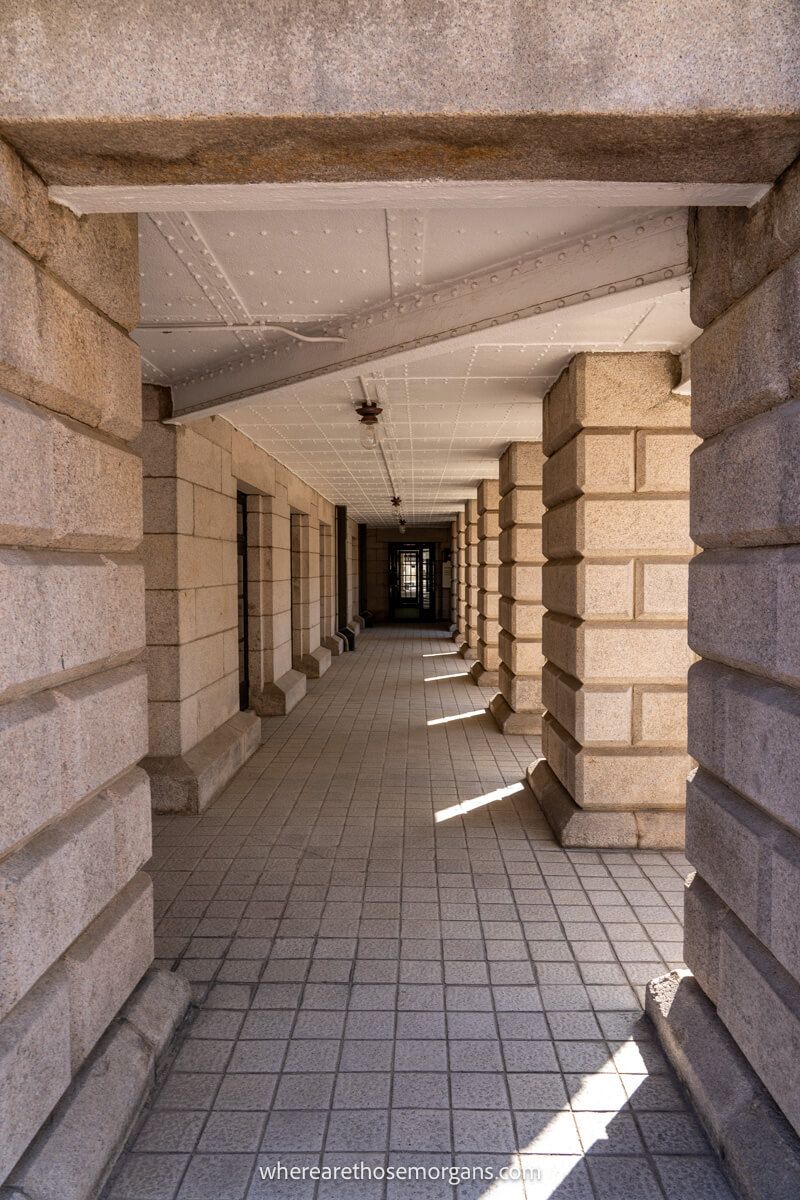
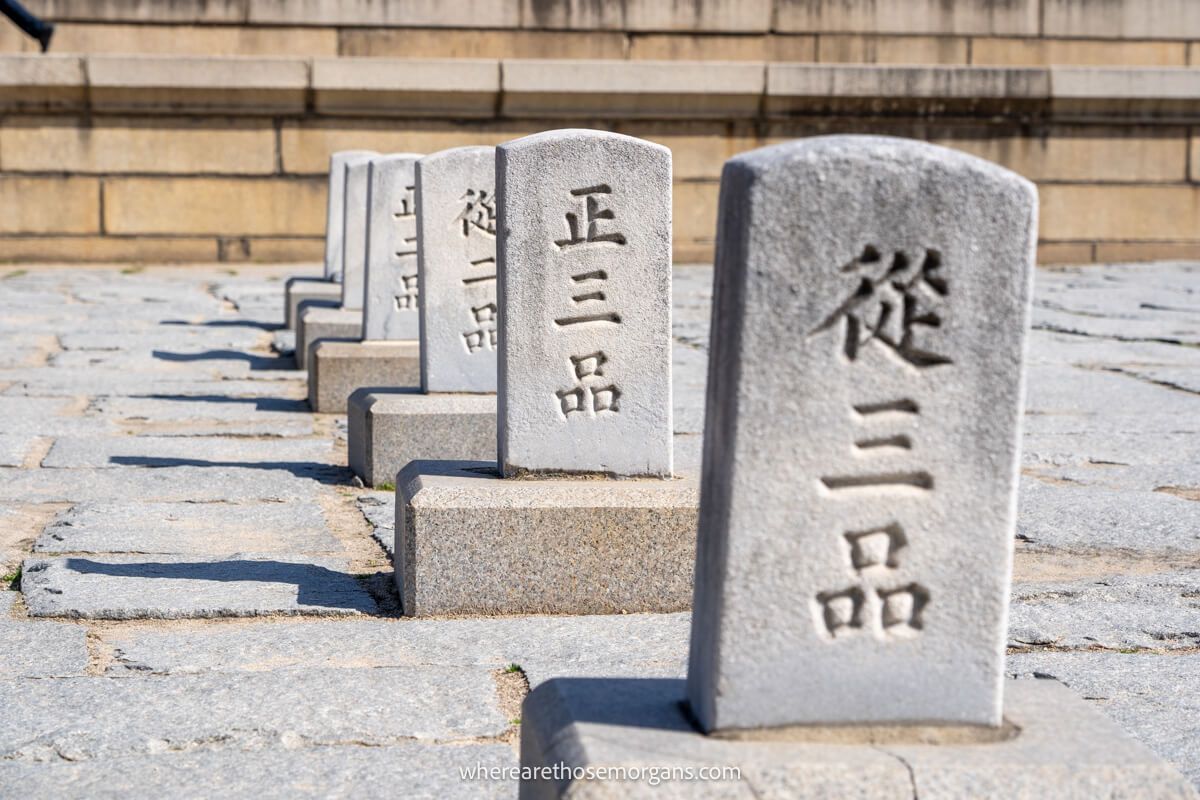
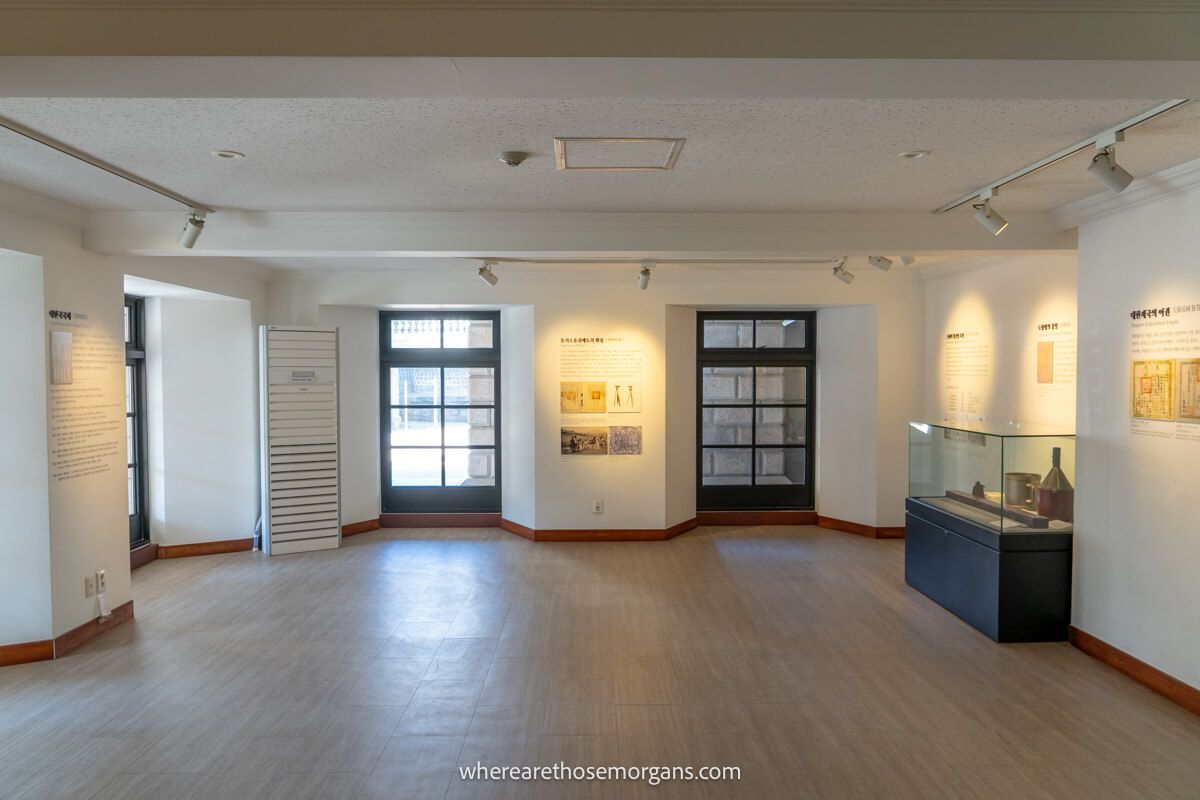
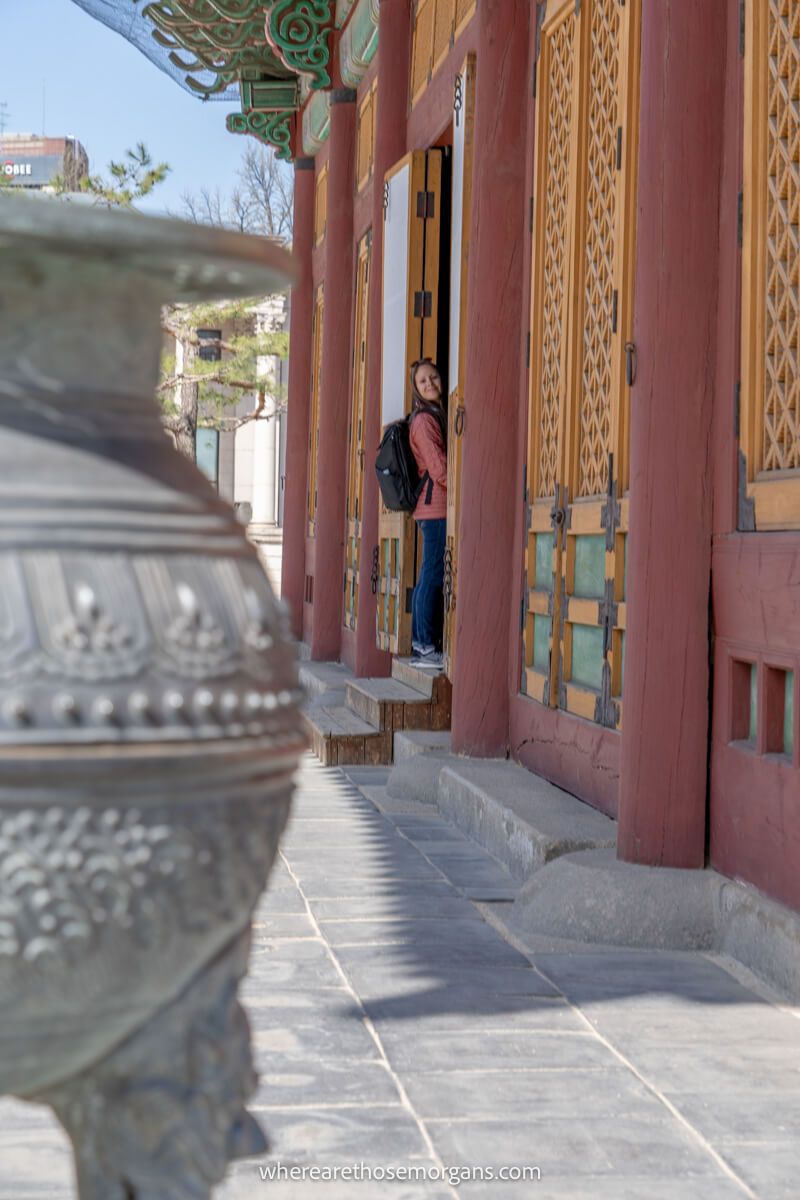
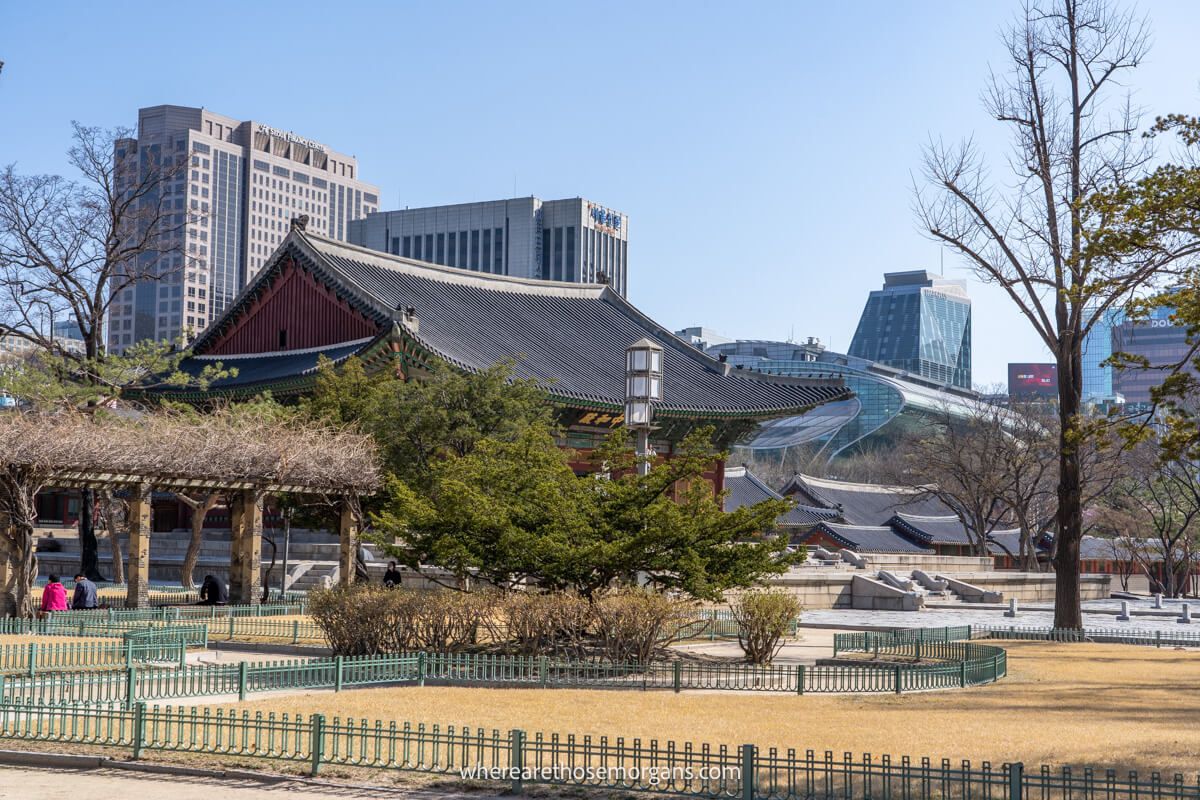
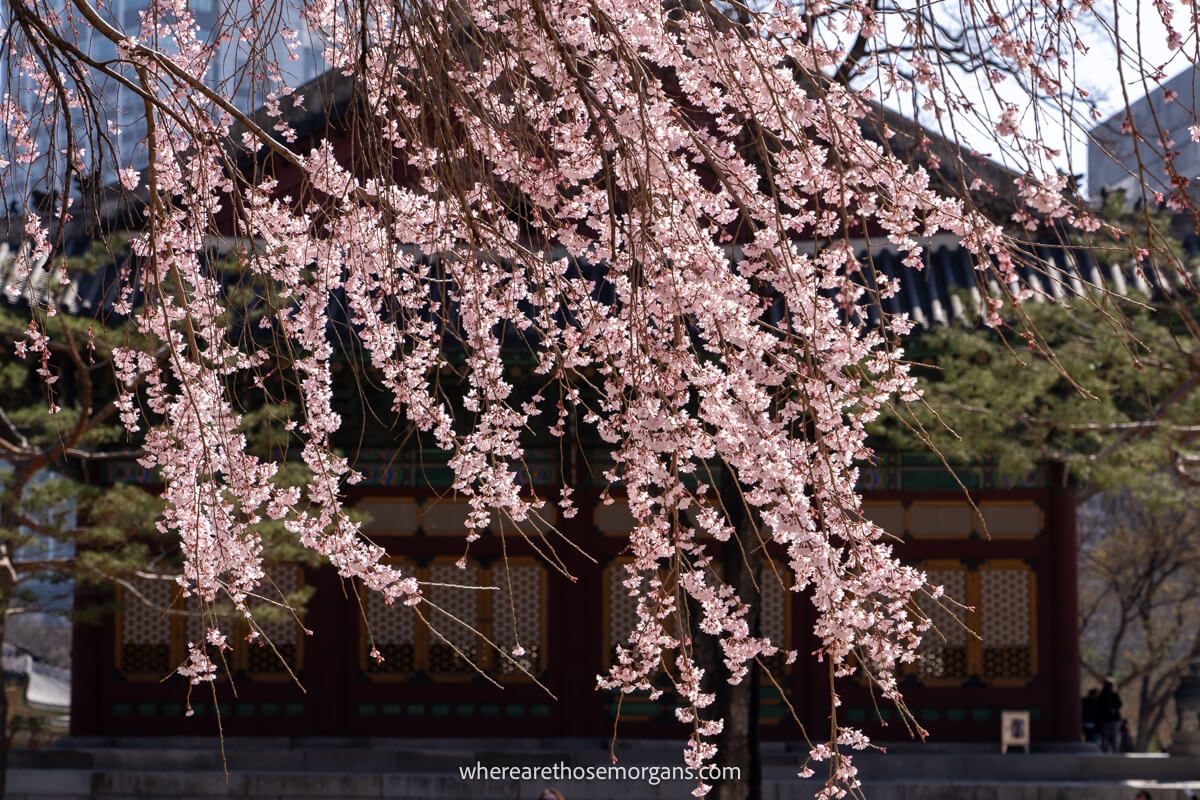
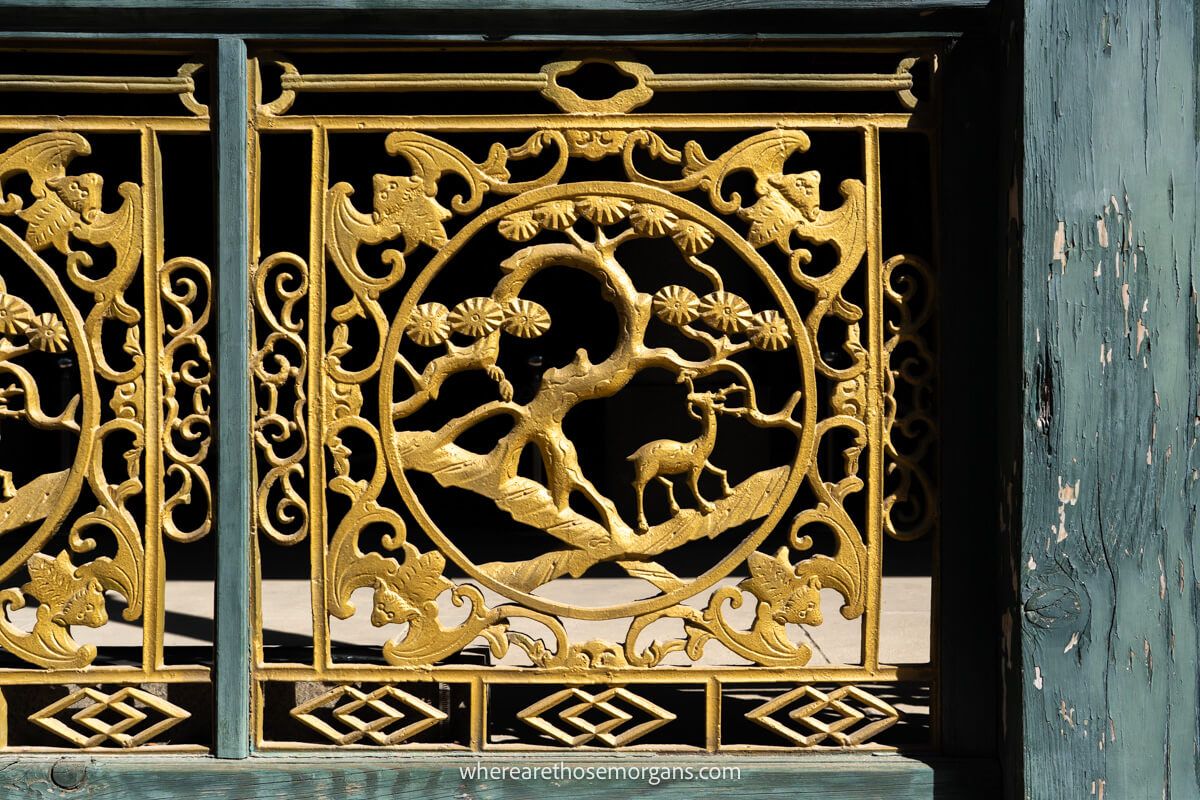
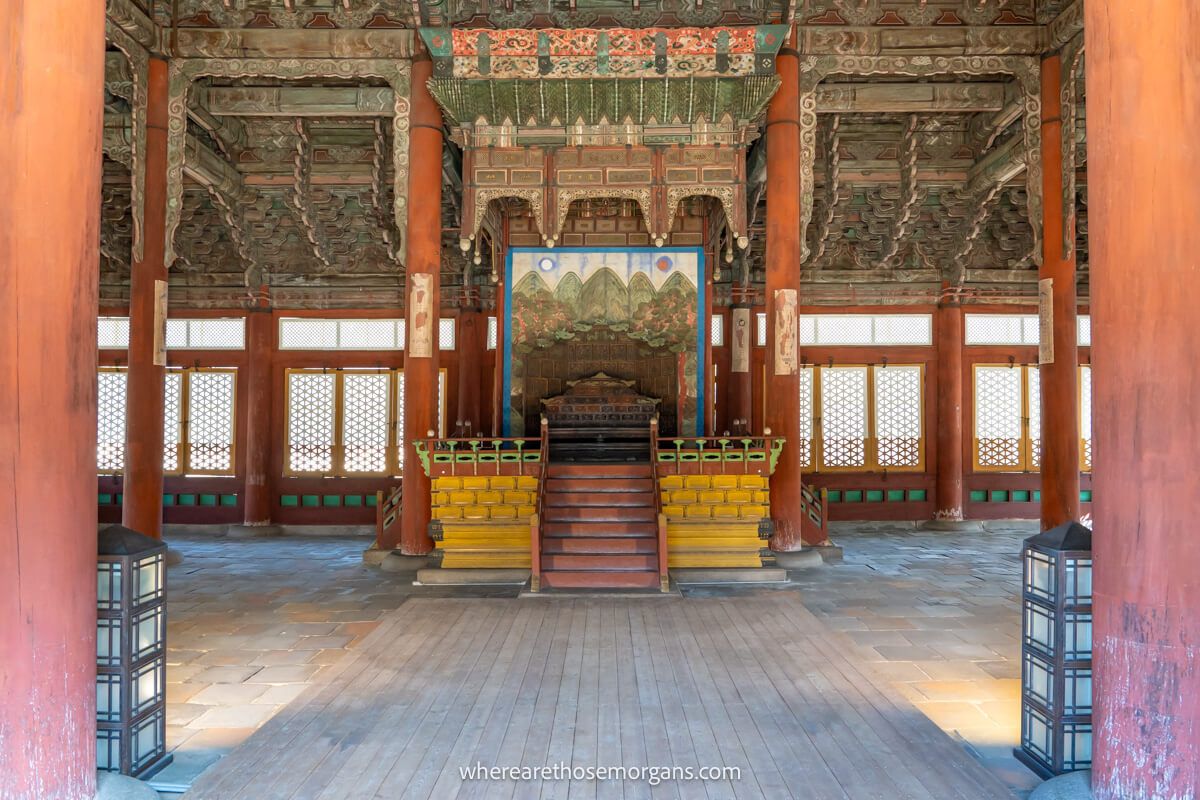
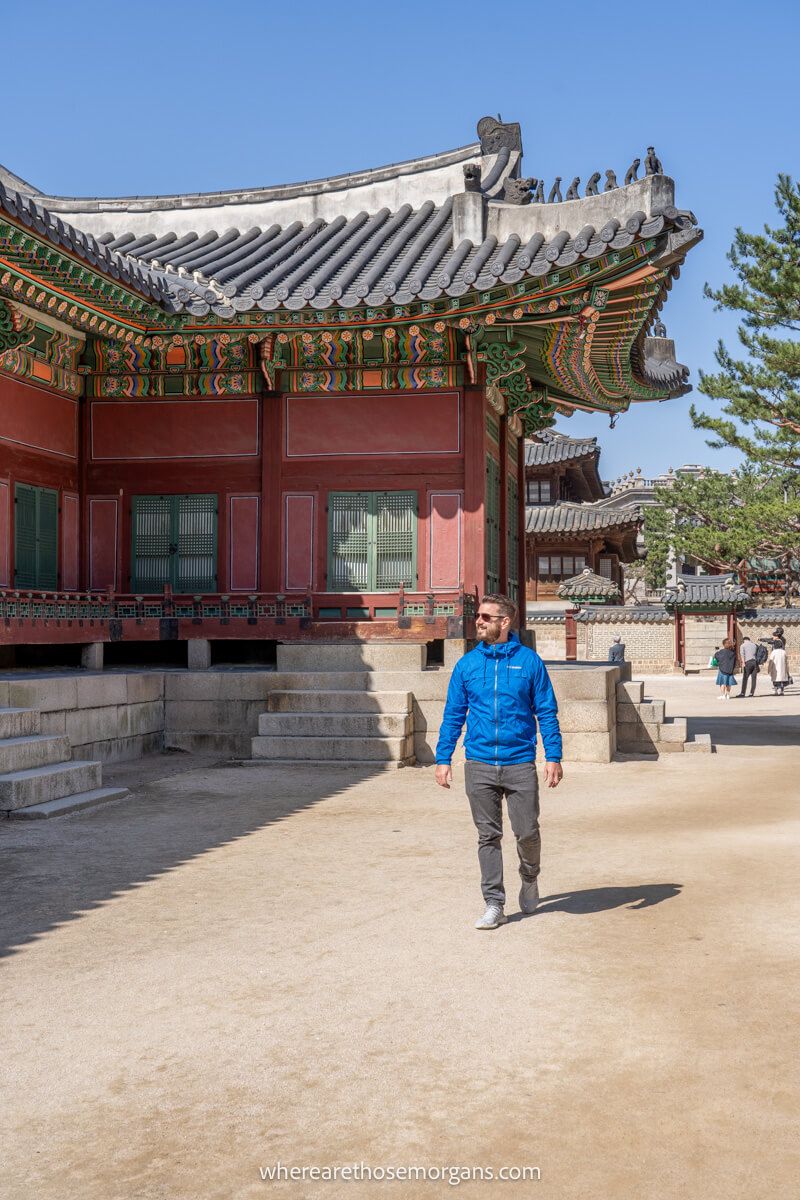
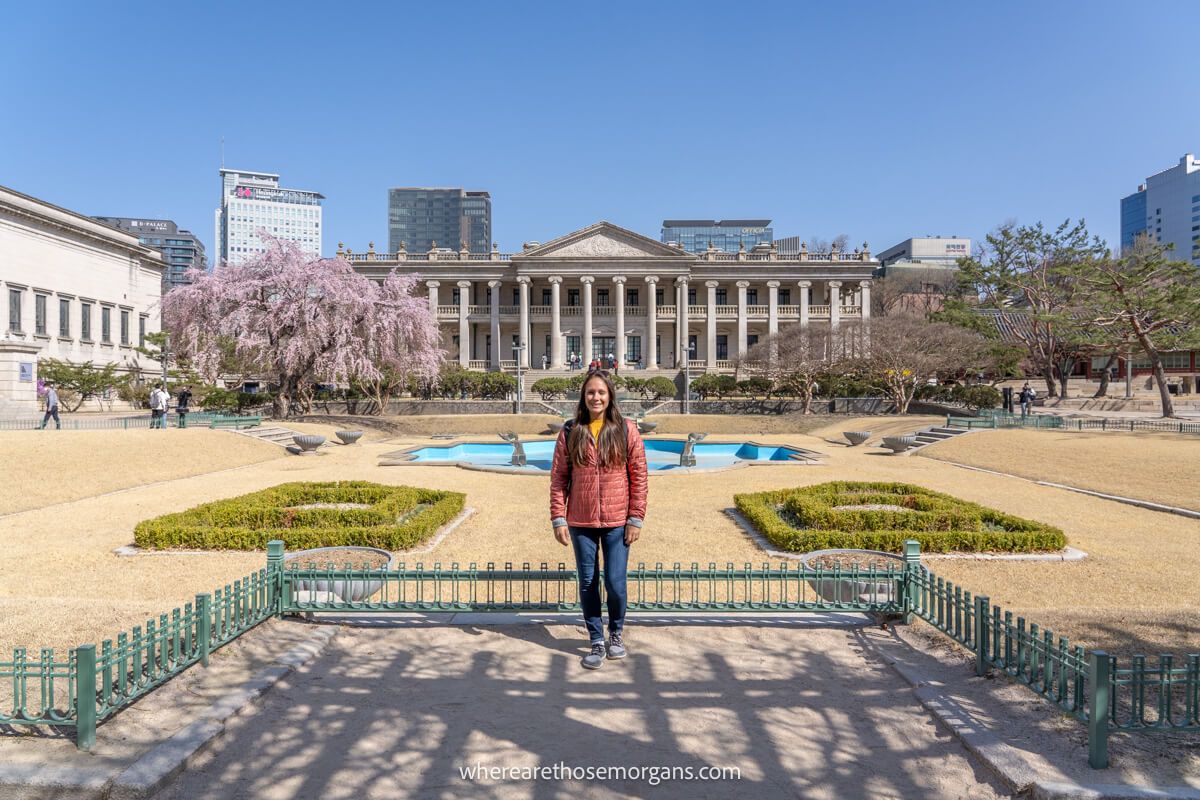
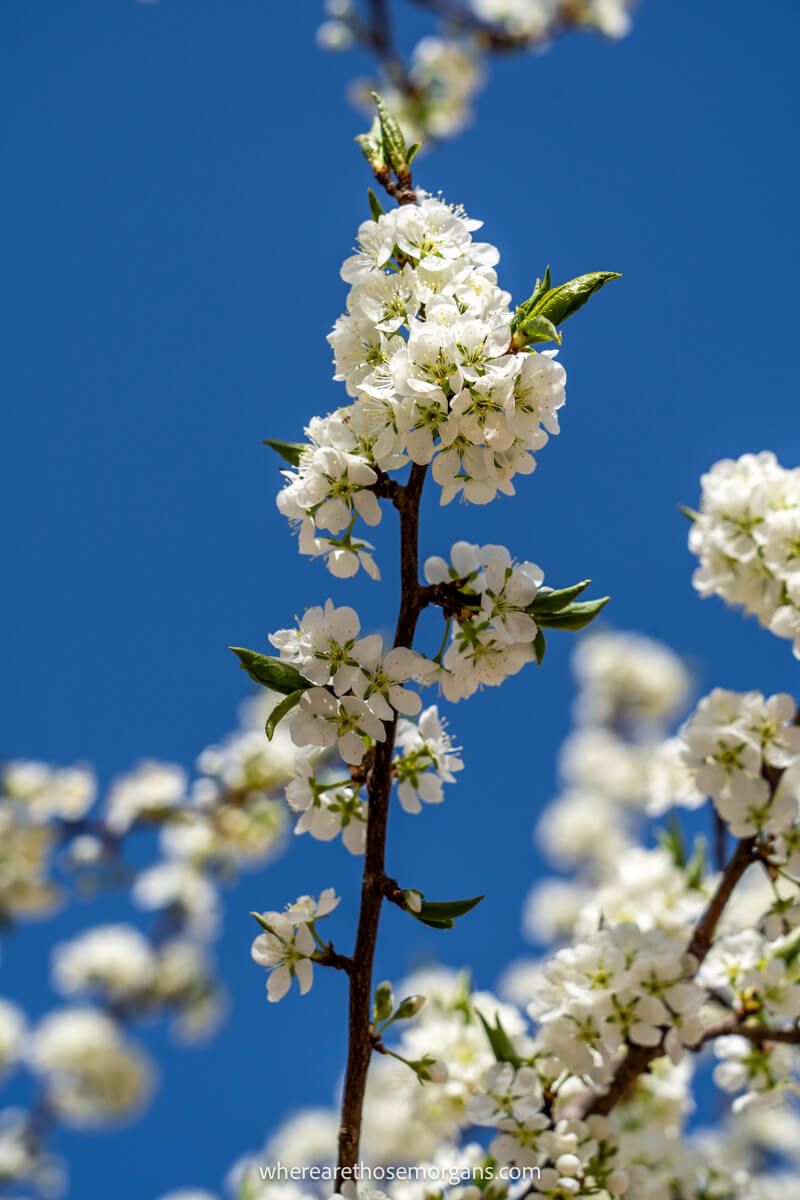
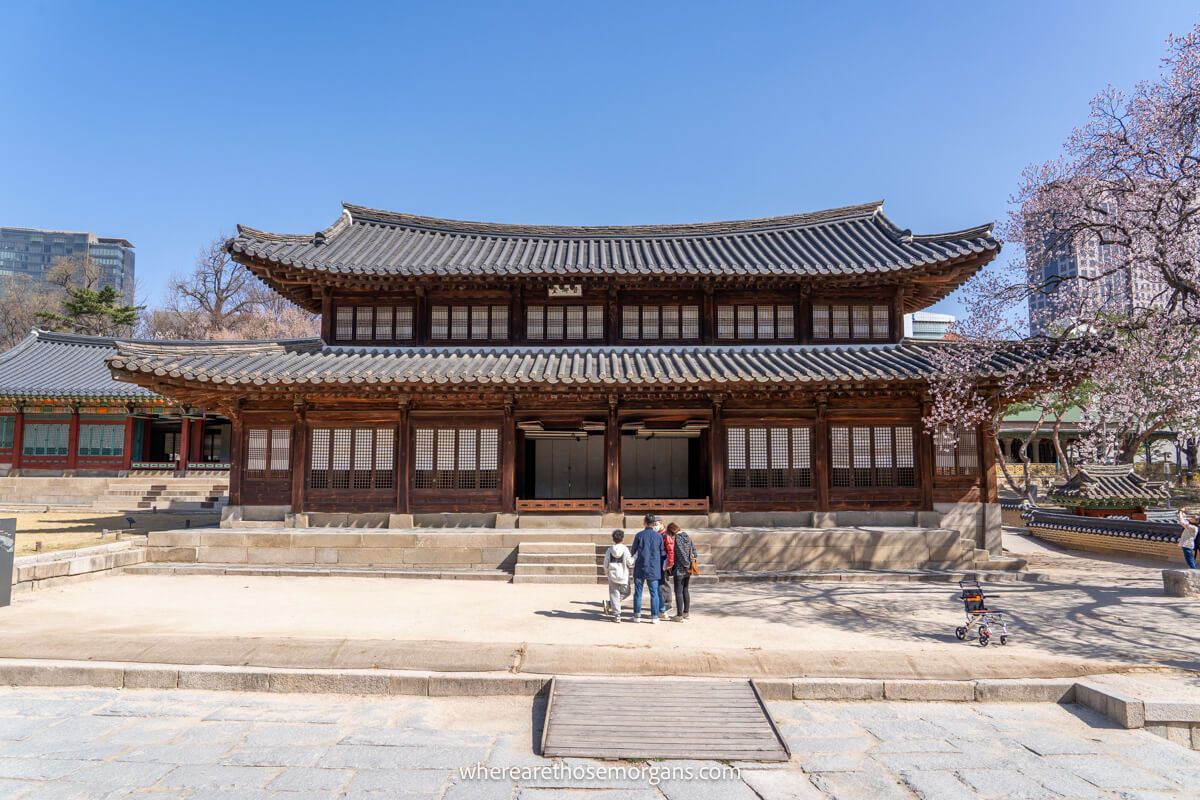
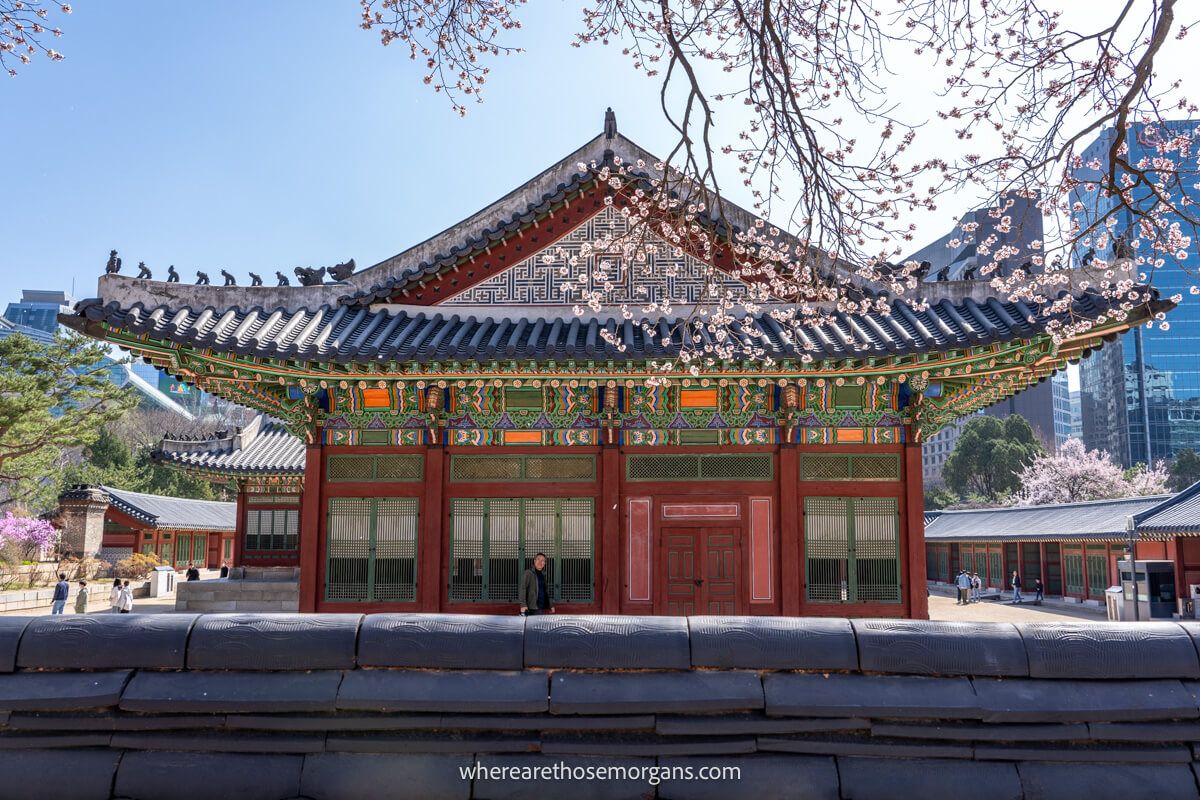
More Seoul Palaces
- Guide to visiting Gyeongbokgung Palace
- How to visit Changdeokgung Palace
- Best things to see inside Seoul’s Secret Garden
- First time visitor guide to Changgyeonggung
- Key sights at Gyeonghuigung Palace
- Best royal palaces to visit in Seoul
Our Popular Seoul Guides
- 35 must see things in Seoul
- Our honest DMZ Tour review
- Best activities at Imjingak Park
- Complete guide to N Seoul Tower
- How to visit the Lotte World observation deck
- Visitor guide for the Jongmyo Shrine
- First time visitor guide to Seodaemun Prison
- 20 top rated hotels in Seoul
Want more Seoul content? Head over to our South Korea Travel Guides to explore the very best of Seoul and beyond.
We hope this guide featuring what to see at Deoksugung Palace helps with planning your visit to Seoul!
Please let us know if you have any questions about visiting this palace or Seoul in the comments below.
Happy Travels,
Mark and Kristen
Enjoy this Deoksugung Palace guide? Pin it for your visit!
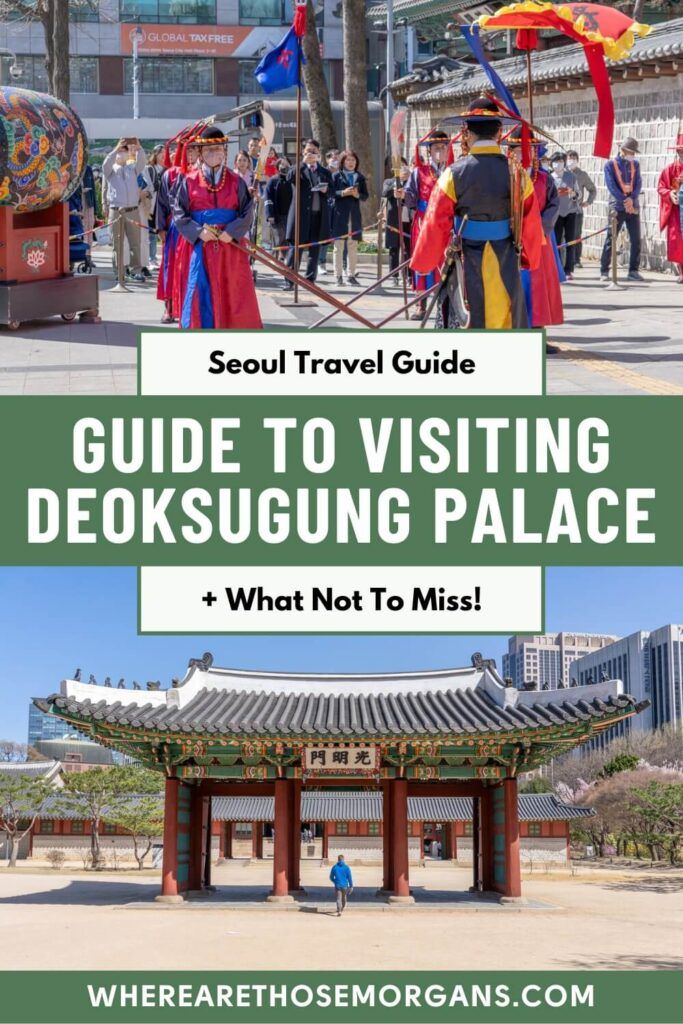
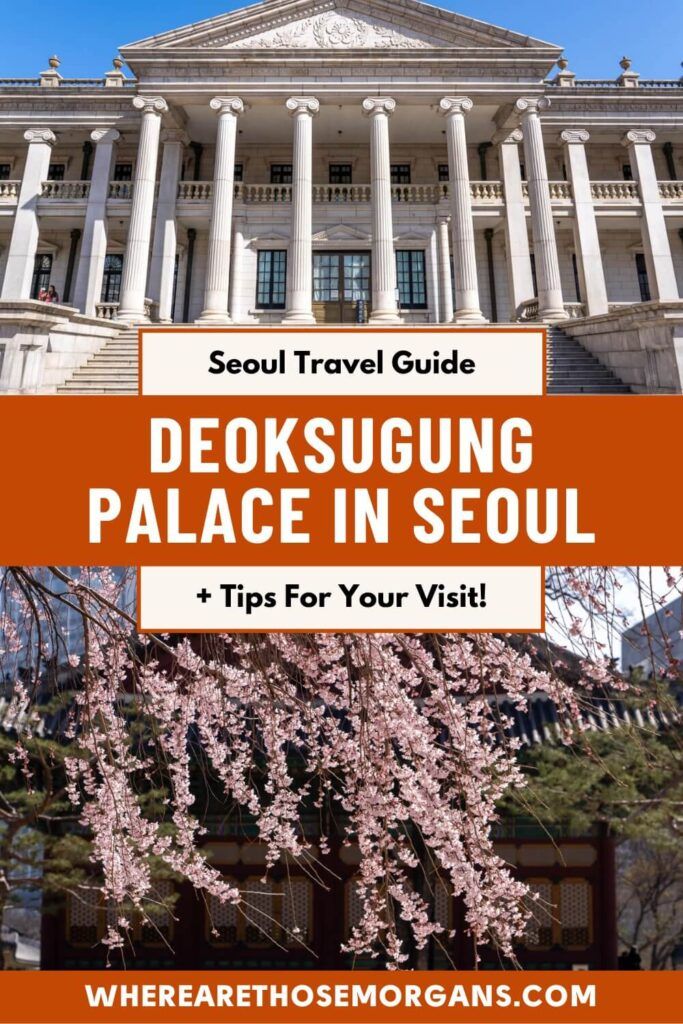
Note: This article contains affiliate links. When you make a purchase using one of these affiliate links, we may earn a small commission at no extra cost to you.
All Rights Reserved © Where Are Those Morgans, LLC. Republishing this article and/or any of its contents (text, photography, maps, graphics, etc.) in whole or in part is strictly prohibited.
Mark and Kristen Morgan are travel, hiking and photography experts. Over the last 6 years traveling full time, they have explored more than 40 countries and 30 US states.
Where Are Those Morgans has been featured in USA Today, Gestalten, Get Your Guide, CityPASS and Condé Nast Traveler along with various other publications. Read more about us.

